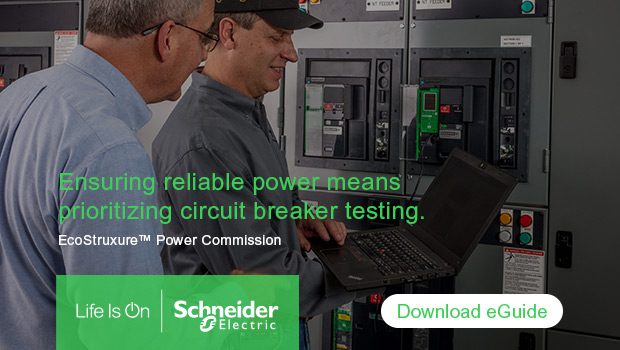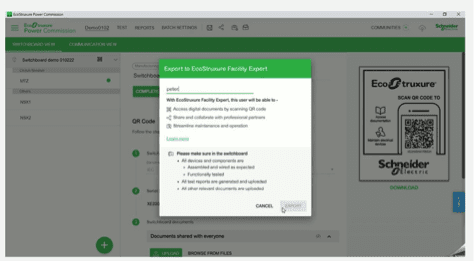Circuit breakers help ensure the safety and reliability of electrical distribution systems in all facility types. Low-voltage (LV) circuit breakers need checking to ensure proper configuration to operate as expected during their entire lifecycle.
This validation is the combined responsibility of specifiers, panel builders, installers, and service technicians. This post explains why, when, how, and by whom should perform testing and how the newest software makes it faster and easier to perform and share test reports.

The importance of properly configuring LV circuit breakers
Most circuit breakers used in final distribution for simple protection are non-adjustable and require no special configuration. However, when it comes to an LV circuit breaker rated above 100A – such as a moulded case circuit breaker (MCCB) or an air circuit breaker (ACB) – proper configuration becomes critical.
These devices protect against overloads, short circuits, and earth faults. They are also designed for selectivity and cascading, helping to minimize the impact of faults while maintaining supply continuity across a facility.
During the design stage of any new build, upgrade, or expansion, advanced software tools like ETAP and Caneco ONE are used to specify the correct settings for each breaker.
Applying these settings accurately, and verifying them through regular circuit breaker testing, is essential. It ensures that the electrical installation remains safe, reliable, and efficient throughout its operational life, ultimately protecting both critical assets and business continuity.
Circuit breaker checking validates the configuration
There are three important reasons to check circuit breakers to certify proper configuration and operation:
- Safety – The ability of a circuit breaker to reliably disconnect in the case of overcurrent or earth fault is a matter of property and people protection. Proper functioning relies on consistency between circuit-breaker setting, tripping curves, and power system characteristics (e.g., rated power of sources, impedances, length, and cross-section of cables).
- Continuity of supply – One way to solve the previous requirement is to have a very sensitive circuit breaker with a low threshold and time delay, but this will create issues due to unwanted tripping or selectivity issues. That will result in forcing settings to maximum values, potentially impairing safety. So the perfect compromise between safety and supply continuity is entirely dependent on the correct application of the settings calculated during design.
- Standards compliance – Part 6 of the IEC 60364-6 standard for LV installations – and multiple local regulations such as BS7671 and NFC15100 – require overcurrent protective devices tripping values to be checked during installation and periodically during operation.
Though circuit breakers must be properly configured, it is unfortunately prevalent that large numbers of breakers do not have their optimized settings configured when buildings are designed, constructed, and operated. We estimate that at least one-third of adjustable circuit-breaker remain with factory settings. There can be many reasons for this:
- According to the actual installation, the initial design calculation is done without the necessary information and is not current. For example, it is typical that the load list may evolve, cable types and lengths may change, or the setting capability is more than initially calculated for a circuit breaker.
- No one thinks it’s their responsibility to configure the circuit breakers.
- Settings are manual, and checking is visual, increasing the chance of human error.
- Settings are modified during operation to solve an issue quickly.
If not configured, circuit breaker settings remain in their factory defaults. A circuit breaker with factory settings might still pass a building inspection, but there is the risk of:
- Non-conformity to the installation standard
- Non-selectivity or unexpected circuit breaker tripping for the installation
Checking circuit breaker settings during the construction phase and periodically during the facility’s operation will avoid these risks by ensuring conformity of the built installation with the calculations done during design. However, mandatory checking is usually performed visually. This poses a risk of human error with poor traceability.
Additionally, periodically testing circuit breakers is an essential preventative maintenance step to help find early indications of a potential operational issue. Circuit breakers may be inactive for months or years before a fault. This will give you time to fix the issue before it can cause a problem.
Recommended steps for circuit breaker testing
As per the standards noted above, checking LV circuit breaker settings should be executed multiple times over the circuit breaker’s lifecycle. Here are some additional considerations:
Testing at the initial installation stage:
- Checking adjustable circuit breaker settings should be prescribed for all new electrical installations.
- The panel builder or electrical contractor should be responsible for this early verification phase.
- Before putting electrical equipment into operation, check the protection settings on circuit breakers and perform testing to verify the functioning of the breakers in accordance with these settings.
- Details of configuration should be entered into a digital logbook – such as EcoStruxure Facility Expert – to set a ‘baseline’ for the configuration and ensure traceability. This record should also include all details for the associated switchboard.
- The panel builder or contractor performing the settings check should deliver a test report to the specifier and building owner to ensure correct settings and operational tests. This should be delivered before starting the installation.

Periodic testing during facility operation:
- For example, the contracted electrical service, a Schneider Electric EcoXpert™ partner, should be responsible for this stage of checking settings and testing performance.
- Though the IEC 60364-6 standard specifies that the testing period is dependent on the installation, equipment, and type of operation. For example, for the ComPacT NSX from Schneider Electric, we recommend testing the trip curve every two years under normal environmental conditions.
- The test procedure should include testing the ability of the circuit breaker to detect an overcurrent and trip (including the mechanical part). It should also include checking that all settings are consistent with the original design specification, including protected circuit characteristics and selectivity objectives.
New technology makes circuit breaker testing simpler, faster, and more reliable
EcoStruxure™ Power Commission (formerly known as Ecoreach) is an intelligent digital testing tool compatible with all Schneider Electric circuit breakers with electronic trip units, power and energy meters, and communication gateways. EcoStruxure Power Commission is a software app that runs on a laptop computer. This mobility makes it ideal for circuit breaker initial validation testing before installation and periodic testing during facility operations.
EcoStruxure Power Commission automates setting, commissioning, and testing, making these steps safer, faster, and more reliable, with less human error. The newest version of this software is simplified to allow direct connection of the laptop to any Schneider Electric MasterPacT MCB or ComPacT MCCB circuit breaker with as little as a USB cable or Field Services Interface. It supports routine checkups, secondary injection testing, preparation for primary injection testing (if required in special cases), and zone selective interlocking testing.
Settings are automatically documented in a digital logbook to save time while enabling consistency and traceability. EcoStruxure Power Commission can also quickly and automatically generate a project report to share with all stakeholders to give them peace of mind that circuit breakers are correctly configured and performing safely and reliably.

In the future, we envision digital design tools like ETAP or Caneco BT software to offer seamless connectivity between the ‘digital twin’ and EcoStruxure Power Commission. This will enable direct upload of specified settings for each breaker in the electrical system for even greater time savings.
To learn more, discover EcoStruxure Power Commission or watch our demonstration video.



